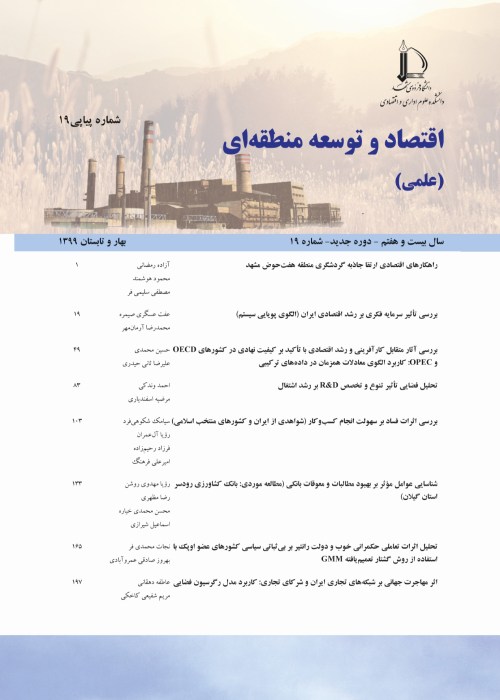Evaluation of Townships of Khorasan Razavi Based on Indicators of Sustainable Development
Author(s):
Abstract:
Introduction
Environmental fans believe that sustainable development depends on future needs to balance the objectives of social, economic and environmental development. Although these goals are contradictory in the short term, but will strengthen each other in the long term. Sustainable economic growth depends on a specific amount of resources, such as pollution absorption and resource regeneration. The responsible use of environmental resources makes the development of long-term stability is achieved. Sustainability is an extensive and complex, and not a deliberate action on the basis of an agent. The most important factors include: economic, environmental, social, physical and institutional. Sustainable development indicators means by which the measure the degree of development, as well as measure the success or failure of development programs. So is inevitable enjoying economic indicators, environmental, social, physical and institutional planning process and its implementation. National undesirable planning has revealed the extreme differences in geographical areas of infrastructure development in the country. The process of development is not the same in a province, such as the development of the province. Therefore it is necessary levels of stability in the period analyzed. Can provide solutions and policies upgrade sustainability by assessing the current situation. Therefore it is necessary levels of stability in the period analyzed. Can provide solutions and policies upgrade sustainability by assessing the current situation. The aim of this study is to prioritize the upgrade sustainable townships of Khorasan Razavi.Theoretical frame work: World Commission on Environment and Development has identified the precise objectives and the broad for sustainable development. These include: continuous increase growth, change the quality of growth, essential needs for jobs, food, energy, water, and health, in a much stable population control, conservation of resources, technological change, considering both the environment and economics in decision-making; the transformation of international relations, partnership development. These postulates of sustainable development as well as the theoretical framework of the paper forms. The purpose of this paper is to determine indicators of sustainable development based on the sustainable development literature to prioritize the development of the townships of Khorasan Razavi province. The research hypothesis is: between the townships of Khorasan Razavi province, there are differences and inequalities in terms of sustainable development.
Methodology
To test the hypothesis, a number of variables were selected as indicators of economic, environmental, social, physical and institutional. Then, using software SPSS, and R factor analysis, was built index. Was obtained by Morris Inequality index, and standardized scores, status and rank townships. This type of applied research, and the research method is descriptive analysis. Location research, Khorasan Razavi province. Data for 27 townships in the province have been extracted from the 2011 population census statistics.Results
Varimax rotation has been reduced by 60 index to 5 factors. A total of five factors covered 76.6% of the variance. Contribution (social - bio) 34.2 percent, share of (bio - socio-economic) 20.3 percent, share of (economic - institutional) 9.9 percent, contribution (social - bio) 7.8%, and contribution (bio-physical) 4.3 percent. Rank development of each township is determined based on the lowest rating standard. Townships with less points are the priority planning. Township development priority factor scores were calculated by using a regression model using the software SPSS. The five-factor model dependent and independent variables is Morris Inequality index. Beta coefficient regression model determines the priority factors. Social - biological factor first priority and environmental - social - economic factor priority is fifth.Conclusion
Morris Inequality index showed except Mashhad and Gonabad, all of the townships had low development. But according to a standardized score, the townships of Khushab, Zaveh, and takhtjolgeh is semi -unstable. And the townships of Mashhad, Gonabab and Bajestan a metastable (developed); and other townships of development are low. By comparing the standardized score townships, hypothesis is confirmed and the most important factor for sustainable development, social - bio factor in the province.are differences and inequalities among selection criteria of sustainable development at 27 city in Khorasan Razavi province. In all methods examined in this study, the cities of Khushab, Zaveh and takhtjolgeh were semi-stable, Bajestan, Gonabad and Mashhad were in medium level of development and the other cities had the low degree of development. The priority of predictor variables of sustainable development are as follows: social factors - biological, economic - social, economic, institutional, bio-physical, biological and socio - economic.
Language:
Persian
Published:
Journal of Economy and Regional Development, Volume:22 Issue: 10, 2016
Pages:
140 to 162
magiran.com/p1523201
دانلود و مطالعه متن این مقاله با یکی از روشهای زیر امکان پذیر است:
اشتراک شخصی
با عضویت و پرداخت آنلاین حق اشتراک یکساله به مبلغ 1,390,000ريال میتوانید 70 عنوان مطلب دانلود کنید!
اشتراک سازمانی
به کتابخانه دانشگاه یا محل کار خود پیشنهاد کنید تا اشتراک سازمانی این پایگاه را برای دسترسی نامحدود همه کاربران به متن مطالب تهیه نمایند!
توجه!
- حق عضویت دریافتی صرف حمایت از نشریات عضو و نگهداری، تکمیل و توسعه مگیران میشود.
- پرداخت حق اشتراک و دانلود مقالات اجازه بازنشر آن در سایر رسانههای چاپی و دیجیتال را به کاربر نمیدهد.
In order to view content subscription is required
Personal subscription
Subscribe magiran.com for 70 € euros via PayPal and download 70 articles during a year.
Organization subscription
Please contact us to subscribe your university or library for unlimited access!


